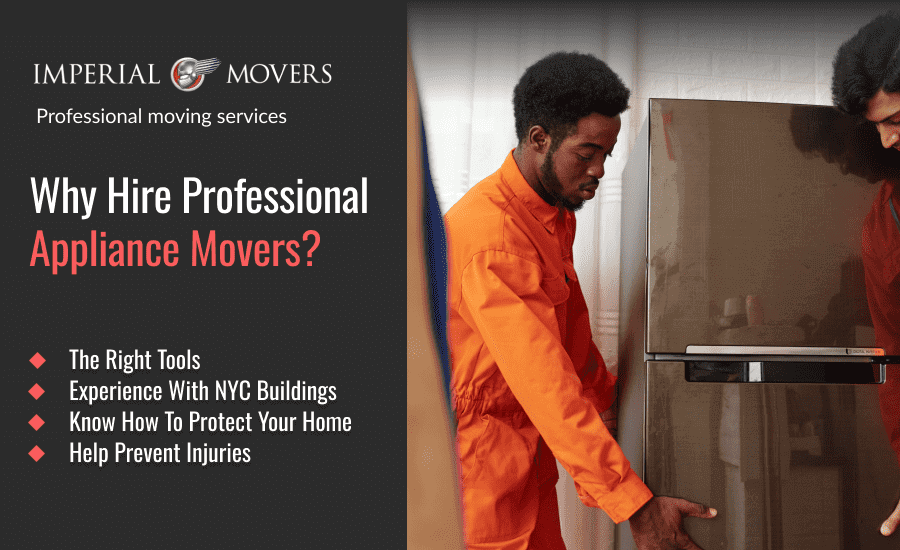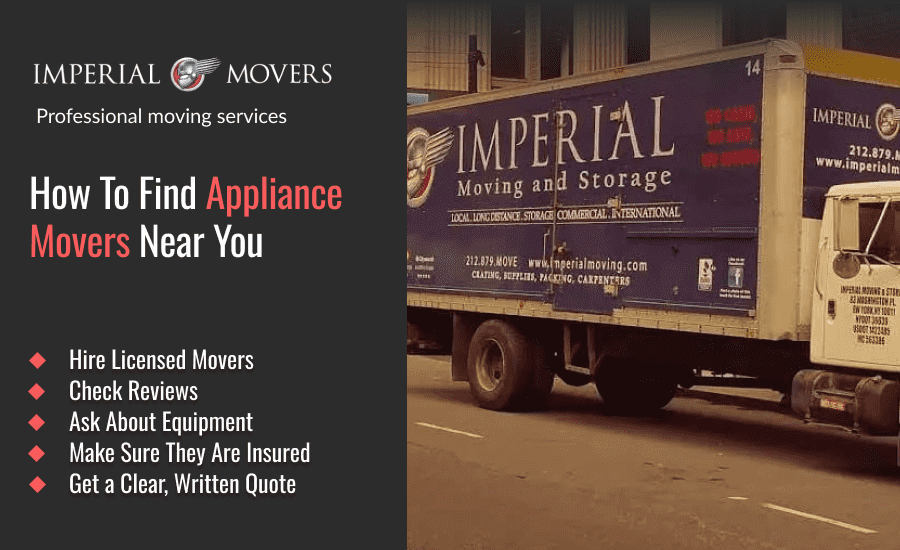Appliance Movers: Key Takeaways
- Prep kitchen appliances before moving them: empty, clean, dry, and secure components to prevent mold, damage, or injury
- Unplug appliances, shut off gas or water lines, and tape cords and doors to avoid leaks, scratches, or accidents
- Use the right tools: an appliance dolly, moving blankets, ratchet straps, and furniture sliders
- If your appliances are oversized, built-in, or you live in an apartment with limited accessibility, hire professional appliance movers
By 2030, more than 221 million refrigerators are expected to be sold worldwide.
That’s a lot of fridges changing hands. But what happens when your fridge must change homes?
In this guide, we’ll explain:
- How to move large kitchen appliances: refrigerators, ovens, washing machines, and dishwashers
- What tools you’ll need in the process
- Why calling appliance movers may be a good idea
- How to find appliance movers near you
Don’t let a wrong move break your kitchen appliance. Call Imperial Movers
How To Move Large Kitchen Appliances
Large kitchen appliances are bulky, delicate, and expensive to replace. That’s why to move them on your own you should know exactly what to expect at every stage of the process.
How To Move a Refrigerator
- Empty & defrost: Remove any food and unplug your fridge at least 6–8 hours in advance. This gives it time to defrost properly and reduces excess moisture.
- Clean & dry: Wipe down all the interior surfaces, especially if you’re moving long distance or storing the appliance for a while. You don’t want to bring mold to your new home.
- Remove shelves: Take out the glass shelves and pack them separately, labeling each to facilitate reassembly.
- Disconnect the water line: If your fridge has a water dispenser or ice maker, disconnect the line and empty the reservoir, then dry all parts.
- Secure loose parts: Tape the power cord to your fridge’s back to prevent it from dangling and increasing the risk of tripping or getting caught in doorways. Collect small parts, put them in a plastic bag, and tape it in the same way.
- Secure the doors: Use rope or strong tape to keep the doors from swinging open. Why? Swinging open can damage the hinges, scratch other surfaces, or cause injury.
- Move the fridge upright: Transport the refrigerator upright using an appliance dolly and ratchet strap. Note that tilting can damage the compressor.
- Secure during transport: Tie down the fridge in the truck to secure it in place and protect it from shifting.
- Wait before powering on: Leave the fridge for 2–3 hours before plugging to allow the fluids to flow back into the compressor.
How To Move an Oven
No one wants a dented oven. Moving one, especially if you have a gas model, can be risky if you don’t know enough about the process.
- Turn off gas: Shut off the gas supply at the valve. If disconnecting the line feels challenging, call in a certified technician. It’s not worth taking the risk playing with a gas oven.
- Remove racks & accessories: Pack each item separately to avoid shifting and damage.
- Protect floors: Slide cardboard or plywood under the oven legs to prevent your floor from scratches.
- Secure the door: If your model allows, remove the door. If not, tape it so it doesn’t open during the move. Don’t pull on the door handle as it can snap under the weight.
- Use a dolly: Place the oven on an appliance dolly, strapping it tightly.
- Transport carefully: Tie the oven down in your moving truck to keep it from sliding.
How To Move a Washing Machine
- Run a clean cycle: It will flush out detergent residue and water.
- Shut off & drain: Turn off water supply valves and disconnect hoses. Drain all water into a bucket.
- Secure drum: Use a transit bolt kit (used specifically with washing machines) to secure the drum and protect suspension parts from damage.
- Bundle accessories: Put hoses, cords, and small parts in a bag, label it, then tape to the back.
- Wrap & load: Cover the washer with moving blankets and use a dolly to wheel it into the truck.
How To Move a Dishwasher
Typically built-in, dishwashers require extra attention when moved.
- Empty & clean: Run an empty cycle with a cleaning agent. Then open the door and leave until the machine is fully dry.
- Turn off power & water: Turn off the water supply and disconnect the power.
- Disconnect lines: Place towels on the floor in case of spills, then remove the drain and water supply lines.
- Secure internal racks: Remove loose racks or trays from the appliance and pack them separately or tie them down so they don’t shift or get damaged.
- Tape the door: Use painter’s tape to close the dishwasher’s door and prevent it from swinging open and hitting you or damaging other items.
- Protect & move: Use thick blankets to wrap and secure the dishwasher to a dolly. Then strap it for safe transportation.
Equipment for Moving Heavy Kitchen Appliances
To move your kitchen appliances to your new apartment, you’ll need a few moving essentials:
- An appliance dolly (the one that has strap harnesses)
- Thick blankets or pads for protection
- Ratchet straps and rope
- Furniture sliders to move along tight corners
- Packing tape
- Zip bags so that your cords and parts don’t disappear mid-move
- Transit bolts for your washer

If you’re moving a large kitchen appliance yourself, you should have a few tools ready
Why Hire Professional Appliance Movers
You might be an enthusiastic DIY mover who has done this exercise dozens of times before. Or have friends assuring you it’ll be cheaper if they help you.
Don’t agree to this at once.
Hiring appliance movers is safer and more cost-effective if you have many appliances, and they are built-in, oversized, or you live in tight spaces and there’s no elevator (hello, NYC walkups!)
Professional appliance movers:
- Help prevent injuries by doing the heavy lifting for you.
- Have the right tools for the job: dollies, straps, and protective padding.
- Are experienced in navigating tight stairwells, elevators, and narrow hallways.
- Know how to protect your floors, walls, and doorways during moving, loading, and unloading.
- Know building policies, including Certificates of Insurance (COIs), elevator reservations, and time-restricted move-in windows.

Professional moving companies have the tools and skills to safely relocate your appliances
How To Find Appliance Movers Next to You
Now that you’ve decided to use professional moving services, you might be asking yourself “How do I find appliance movers next to me?”
Finding the right help is easier than you think when you know what to look for.
- Search for licensed movers with verified appliance-handling experience.
- Check online reviews on platforms like Yelp and Google to see if past customers were satisfied with the service.
- Look for movers who offer appliance disconnection and reconnection as part of their service package.
- Ask if they have appliance dollies, furniture straps, and protective padding for safe transport.
- Confirm that they have liability coverage or insurance options in case of damage during the move.
- Request a written estimate with transparent pricing. Avoid companies that give vague quotes.

Use licensed and insured appliance movers with the right equipment
Need To Move Kitchen Appliances? Let Imperial Movers Handle the Heavy Lifting
Moving large kitchen appliances can be challenging if you aren’t strong enough, don’t have the tools, or can’t rely on friends for help.
That’s the time to call Imperial Movers.
A trusted partner for safe, damage-free moves for NYC relocations or long-distance moves, we provide:
- Transparent pricing
- Fast and flexible scheduling
- Secure handling of large kitchen appliances
- Extra care for packing and transportation of expensive and fragile items like pianos and art
- Friendly, professional crews that stay by your side every step of the moving journey
Reach out for a moving quote today and have a cup of coffee with friends while we are taking care of your kitchen appliances.
Skip the heavy lifting. Let Imperial Movers handle the load
Appliance Movers: FAQs
Do movers disconnect appliances?
Yes, our team at Imperial Movers can disconnect and reconnect your appliances if you have selected our full services.
Can I move a fridge on its side?
No, moving a fridge on its side can cause oil to flow into the cooling lines, damaging the compressor. Make sure to keep your fridge in an upright position when moving it to your new apartment.
Can I use a regular dolly instead of an appliance dolly?
No, a regular dolly cannot handle the weight and size of large appliances. Designed specifically for transportation of heavy and bulky appliances, appliance dollies have straps and a supportive frame that help balance the load and reduce the risk of tipping or damage.
Protect your floors and walls. Call Imperial to move your appliances




